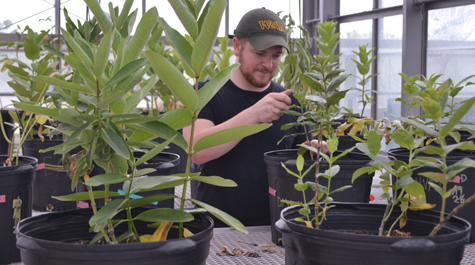At the symposium: Insights into the monarch-milkweed relationship
The late Isaac Asimov said that the most exciting phrase in science is not “eureka!,” but “that’s funny.”
David De La Mater experienced one of those exciting Asimov moments when he was going over data generated by his ecological investigation into regional variations of common milkweed and their relationship to the monarch butterfly.
De La Mater is a master’s student in William & Mary’s Department of Biology. He will receive the William & Mary Interdisciplinary Award for Excellence in Research at the 17th Annual Graduate Research Symposium. The award comes with a $2,000 cash honorarium.
It’s De La Mater’s second prestigious honor, as he was awarded a Graduate Research Fellowship from the National Science Foundation.
 He will give a presentation on his research at the symposium on March 17 from 11 to 11:30 a.m. in Tidewater A in the Sadler Center on the William & Mary campus. De La Mater’s talk, “Range-wide variation in common milkweed traits and the effect of food source on larvae of the monarch butterfly,” will include a discussion of findings he called “cryptic.”
He will give a presentation on his research at the symposium on March 17 from 11 to 11:30 a.m. in Tidewater A in the Sadler Center on the William & Mary campus. De La Mater’s talk, “Range-wide variation in common milkweed traits and the effect of food source on larvae of the monarch butterfly,” will include a discussion of findings he called “cryptic.”
Monarch butterflies are, along with honeybees, among the most charismatic insects of North America. De La Mater focused his research on the Eastern population of the butterflies, and most specifically on Asclepias syriaca — the common milkweed.
De La Mater explained that the well-known milkweed-monarch connection serves as an excellent case study of plant-herbivore ecological interactions. Adult monarchs migrate up from wintering grounds in Mexico and lay eggs on milkweed leaves. The eggs hatch, and the colorful striped larvae regale themselves upon the very same plant. Replete and maturing, the larvae spin up a chrysalis and hang there until they hatch out as the familiar orange-winged adults.
The monarch larvae get protection, as well as nutrition, from milkweed. De La Mater explained that larvae ingest toxic compounds called cardenolides from the milkweed, making them unpalatable to predators.
Recent years have seen a big crash in the monarch population, though. Studies show that over the past 30 years, the eastern population of the species has suffered around an 80 percent loss and mathematical models say there’s a good chance the population will be quasi-extinct within 20 years.
The loss of the population can be blamed on a cluster of causes and De La Mater says it’s likely that the biggest culprit is the logging-related destruction of the insects’ overwintering forest habitat in Mexico. There’s also been significant loss of nectaring plants that the adult monarchs feed on during migration.
There also has been a loss of milkweed, the monarch’s vegetative cradle and nursery. De La Mater wondered how much effect regional variation in the milkweed could have on the development of the monarchs. He set out to conduct what he calls “a census of common milkweed,” mapping traits across the range of the plant. It’s something that hasn’t been done in the scientific literature before, he added.
“There have been people who have studied milkweed, but it’s been very localized,” he said. “It’s been in the east or it’s been in the Midwest. Even if it’s the same species of milkweed, they were dealing with different ecotypes.”
Working with a research team that included his advisor, Harmony Dalgleish, assistant professor of biology, De La Mater began investigating milkweed in the field. The team sampled milkweed over 55 locations, ranging from Atkinson, Maine to Gadsden, Alabama and from Arrowwood National Wildlife Reserve in Minnesota down to Washita, Oklahoma.
Back in the lab at William & Mary, he used spectroradiometry to analyze the nutritional content of the samples. A comparison analysis showed that the milkweed got better and better as you go toward the northeast, with the primo weed being found in New England.
De La Mater also set up a common-garden experiment. He brought plants from his eastern U.S. milkweed tour to the university greenhouse, growing them in identical conditions of soil, light, water and so on. Initial analyses of the common-garden plants corresponded with his field studies.
“The patterns that I was seeing in my preliminary data set turned out to be significant,” he said. “The trait values correlated with latitude, the trait values correlated with longitude, and these between-region variations in plant traits held true.”
And then things started to get curious.
After a year, the geographic differences in the plants leveled out: “The effect vanished,” he said. “As far as what I was seeing in the field. Those things have dissipated over the course of a year in the common garden.”
De La Mater said he wasn’t expecting the values of the plants to reach equilibrium in a common environment, or at least not so rapidly. It’s a significant finding in that it shows how a plant species important to conservation can adapt as climate changes.
The “that’s funny” moment came after De La Mater began raising monarch larvae on his common-garden milkweed.
“I measured larval development in terms of weight gain, length gain, efficiency of digestion,” he said. “I determined that some of the larvae had a significant difference in weight gain.”
The heavier larvae were those that were eating milkweed that was collected in the northeastern parts of the study — even though De La Mater’s lab analysis had showed that the nutritional content of the common-garden plants had leveled out after a year.
“In my analysis of the plants themselves, I couldn’t detect any significant variation with longitude or latitude or between regions,” he explained. “Yet these differences are manifesting themselves at the next trophic level — in larval development.
“So the larvae are experiencing something that we’re unable to detect.”
His findings could be the basis for another set of experiments to tease out the hidden biological explanation for the cryptic effect.
“Unfortunately, I’ve only got two years here,” he said. “I’ve done quite a bit in two years and hopefully someone can build upon my work in the future.”
 Skip to main content
Skip to main content

